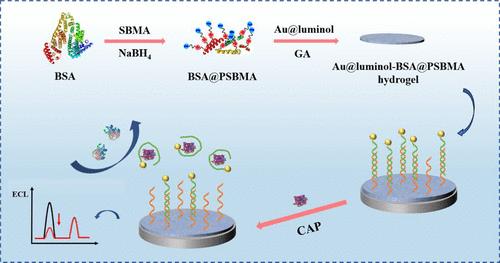具有防污抑菌功能的高效电化学发光生物传感器用于海水中氯霉素的灵敏准确分析
IF 6.7
1区 化学
Q1 CHEMISTRY, ANALYTICAL
引用次数: 0
摘要
在海洋环境监测中,由于海水中存在大量的干扰蛋白和细菌,因此构建具有防污和抗菌功能的高效传感接口以避免上述干扰具有重要意义。在此基础上,研制了以甲基丙烯酸亚砜甜菜碱(SBMA)和牛血清白蛋白(BSA)为基材的两性离子水凝胶作为防污抗菌涂料。两性离子的水合性与水凝胶的亲水性相结合,使BSA@PSBMA具有良好的抗吸附能力,有效地阻碍了蛋白质和细菌的粘附,从而提高了生物传感器的检测灵敏度。同时,SBMA与BSA的共价接枝解决了单个BSA在复杂基质中稳定性差的缺陷,提高了生物传感器的稳定性和使用寿命。此外,将Au@luminol作为内标包封在两性离子水凝胶中,实现了防污和配比策略的一步集成,简化了生物传感器的构建过程。所研制的电化学发光生物传感器对氯霉素的检测具有良好的灵敏度和准确性,线性范围为1 pM ~ 100 nM,检出限低至0.39 pM (S/N = 3),适用于海水中微量抗生素的检测。本文章由计算机程序翻译,如有差异,请以英文原文为准。

High-Efficiency Electrochemiluminescence Biosensor with Antifouling and Antibacterial Functions for Sensitive and Accurate Analysis of Chloramphenicol in Seawater
In marine environmental monitoring, due to the presence of a large number of interfering proteins and bacteria in seawater, it is of great significance to construct an efficient sensing interface with antifouling and antibacterial functions to avoid the aforementioned interferences. On this basis, the zwitterionic hydrogel based on sulfobetaine methacrylate (SBMA) and bovine serum albumin (BSA) was developed as an antifouling and antibacterial coating. The combination of hydration of zwitterions and hydrophilicity of hydrogels endows BSA@PSBMA with good antiadsorption ability, which effectively hinders the adhesion of proteins and bacteria, thereby improving the detection sensitivity of the biosensor. At the same time, the covalent grafting of SBMA and BSA solves the defect of poor stability of individual BSA in complex matrices, improving the stability and service life of the biosensor. In addition, Au@luminol was encapsulated in the zwitterionic hydrogel as an internal standard to realize a one-step integration of antifouling and ratio strategies, which simplifies the construction process of the biosensor. The developed electrochemiluminescence biosensor exhibited good sensitivity and accuracy for chloramphenicol detection, with a wide linear range of 1 pM to 100 nM and a low detection limit of 0.39 pM (S/N = 3), which is suitable for trace detection of antibiotics in seawater.
求助全文
通过发布文献求助,成功后即可免费获取论文全文。
去求助
来源期刊

Analytical Chemistry
化学-分析化学
CiteScore
12.10
自引率
12.20%
发文量
1949
审稿时长
1.4 months
期刊介绍:
Analytical Chemistry, a peer-reviewed research journal, focuses on disseminating new and original knowledge across all branches of analytical chemistry. Fundamental articles may explore general principles of chemical measurement science and need not directly address existing or potential analytical methodology. They can be entirely theoretical or report experimental results. Contributions may cover various phases of analytical operations, including sampling, bioanalysis, electrochemistry, mass spectrometry, microscale and nanoscale systems, environmental analysis, separations, spectroscopy, chemical reactions and selectivity, instrumentation, imaging, surface analysis, and data processing. Papers discussing known analytical methods should present a significant, original application of the method, a notable improvement, or results on an important analyte.
 求助内容:
求助内容: 应助结果提醒方式:
应助结果提醒方式:


